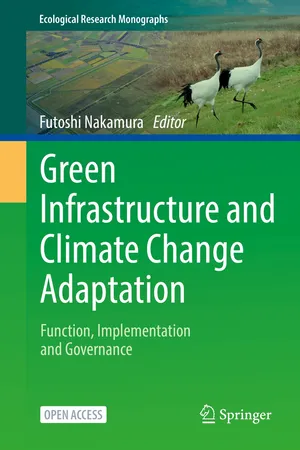
Green Infrastructure and Climate Change Adaptation
Function, Implementation and Governance
- English
- ePUB (mobile friendly)
- Available on iOS & Android
Green Infrastructure and Climate Change Adaptation
Function, Implementation and Governance
About this book
This open access book introduces the function, implementation and governance of green infrastructure in Japan and other countries where lands are geologically fragile and climatologically susceptible to climate change. It proposes green infrastructure as an adaptation strategy for climate change and biodiversity conservation.In the face of climate change, dams, levees and floodways built as disaster prevention facilities do not sufficiently function against extraordinary events such as mega-floods and tsunami disasters. To prevent those disasters and loss of biodiversity in various ecosystems, we should shift from conventional hard measures to more adaptive strategies using various functions that natural and semi-natural ecosystems provide. Green infrastructure is an interconnected network of waterways, wetlands, woodlands, wildlife habitats and other natural areas that support native species, maintain natural ecological processes, sustain air and water resources and contribute to the health and quality of life for communities and people. Green infrastructure has mainly been discussed from adaptation strategy perspectives in cities and urban areas. However, to protect cities, which are generally situated at downstream lower elevations, we explore the preservation and restoration of forests at headwater basins and wetlands along rivers from a catchment perspective. In addition, the quantitative examination of flood risk, biodiversity, and social-economic benefits described in this book brings new perspectives to the discussion.The aim of this book is to accelerate the transformative changes from gray-based adaptation strategies to green- or hybrid-based strategies to adapt to climate change. The book provides essential information on the structure, function, and maintenance of green infrastructure for scientists, university students, government officers, and practitioners.
Frequently asked questions
- Essential is ideal for learners and professionals who enjoy exploring a wide range of subjects. Access the Essential Library with 800,000+ trusted titles and best-sellers across business, personal growth, and the humanities. Includes unlimited reading time and Standard Read Aloud voice.
- Complete: Perfect for advanced learners and researchers needing full, unrestricted access. Unlock 1.4M+ books across hundreds of subjects, including academic and specialized titles. The Complete Plan also includes advanced features like Premium Read Aloud and Research Assistant.
Please note we cannot support devices running on iOS 13 and Android 7 or earlier. Learn more about using the app.
Information
Table of contents
- Cover
- Front Matter
- 1. Introduction
- Part I. Concept and Synthesis
- Part II. Forest Ecosystem
- Part III. River and Floodplain Ecosystem (Including Paddy Field and Other Farmlands)
- Part IV. Wetland Ecosystem (Including Flood-Control Pond)
- Part V. Urban and City Ecosystem
- Part VI. Coast and Estuary Ecosystem
- Part VII. Economic Evaluation
- Part VIII. Governance
- Back Matter